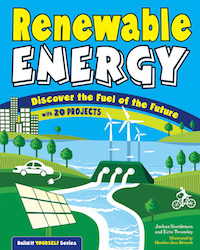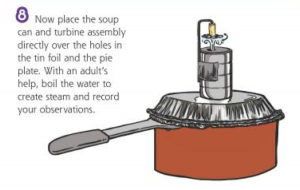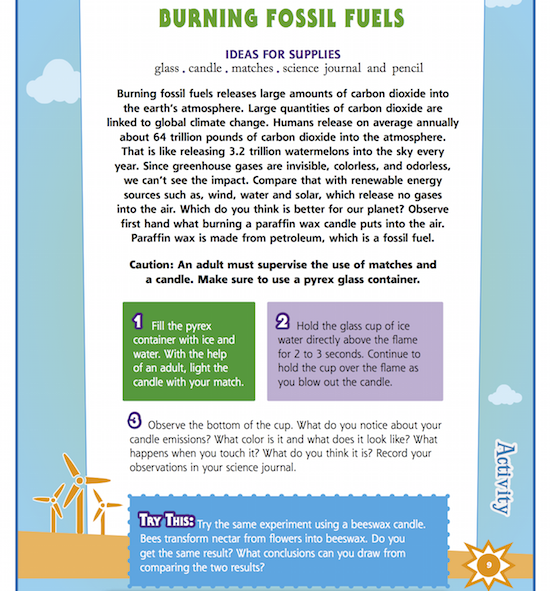Renewable Energy for Teachers & Students
Renewable Energy: Discover the Fuel of the Future with 20 Projects
By Joshua Sneideman and Erin Twamley
(Nomad Press, 2016 – learn more)
Renewable Energy: Discover the Fuel of the Future with 20 Projects packs in so much learning for teachers and students alike. It is definitely a must-have resource for any science teacher who wants to strengthen the focus on renewable energy with project-based learning experiences.
 The book’s enticing illustrations and vibrant colors also make it a resource teachers can share directly with kids. The inviting graphics on the cover continue throughout the book, providing rich visuals that make learning about sustainable energy fun and easy to understand. In stark contrast to most traditional science textbooks, the style of this book is very modern and fresh.
The book’s enticing illustrations and vibrant colors also make it a resource teachers can share directly with kids. The inviting graphics on the cover continue throughout the book, providing rich visuals that make learning about sustainable energy fun and easy to understand. In stark contrast to most traditional science textbooks, the style of this book is very modern and fresh.
This book is well structured and interconnected. Authors Joshua Sneideman and Erin Twamley begin by categorizing five types of renewable power and correlate them to the five rings of the Olympic Games.
In the Olympics, the rings symbolize the five different regions of the world coming together. In that same vein, each of the five major types of renewable energy are similarly interconnected; yellow is for the sun, black is for wind, red is for geothermal, blue is for water, and green is for biomass. This overarching theme is continued throughout the book.
For example, the starting sentence of the chapter “The Power of the Sun” begins with the following quote: “Legend says that the Olympic torch was once lit with fire from the sun. While we can’t actually get close enough to the sun to steal its fire, we can use energy from the sun in many different ways.”
A chapter-by-chapter exploration
Each chapter further explores one of the five types of renewable energy. The chapters are rich with content and full of intriguing renewable energy information that can be incorporated into lessons and shared with students. Additionally, each chapter skillfully connects the past, present, and future of that particular renewable source. This makes each section very engaging for students and teachers, regardless of their familiarity with the subject.
I never knew, for example, that “A ‘heat ray’ weapon used in 214-212 BCE concentrated the sun’s energy using mirrors to burn sails on warring ships.” Did you know that? The book definitely does a good job incorporating the history of different technologies.
While it discusses the future of renewable energy, such as solar-powered transportation, the book also covers the basics of contemporary systems, like the solar photovoltaic “PV” technology that makes up the solar panels on people’s rooftops. This combination of past, present, and future make this book a one-of-a-kind classroom resource, in my experience.
Lots of helpful call-out boxes
In addition to the thorough main text, Renewable Energy provides a rich selection of themed call-out boxes in each section. The themes include “Plugged In,” “Words to Know,” “Green Jobs,” “Primary Sources (PS),” and “Essential Question.”
The first two, “Plugged In” and “Words to Know,” give interesting energy facts and useful definitions to energy terms. “Green Jobs” is especially important because it makes a direct connection between what students are currently studying and how it applies to their potential future careers. This kind of direct linkage is essential to the success of our current STEM initiatives.
There is no better way to teach students than to engage them in interesting environmental and engineering science and then clearly demonstrate specific future career opportunities in the exciting field of renewable energy.
The last boxes, “Primary Sources” and “Essential Question,” go hand in hand to promote inquiry-based learning. Students, of course, are naturally inquisitive. These call-out resources provide students with the tools to question what they are reading. The authors also include QR codes where readers can research and discover more about the topics they find fascinating.
Hands-on project ideas
Finally, another key element that makes this book so useful is the inclusion of very practical and enjoyable hands-on projects at the end of each chapter. These projects will enable students to investigate the principles of sustainable energy that they have just learned about.

I recommend this book for science and STEM teachers looking for ways to enliven instruction and engage students through hands-on learning activities. Definitely plan on sharing Renewable Energy with your students. Multiple copies might be a good idea!
Read a MiddleWeb article by Erin Twamley & Joshua Sneideman
Emily Anders, currently a STEM Coordinator and teacher at Saint Agnes School in Virginia, has been engaging and challenging students in the classroom for over six years. She is a NASA Solar System Ambassador to Virginia and a 2015 winner of the Mickelson ExxonMobil Teachers Academy Scholarship. She earned her Masters in Education in 2010 from Chaminade University (Honolulu) and a Bachelor of Science & Engineering in 2002 from the United States Military Academy at West Point.































Emily, what is your favorite renewable energy and why? Have you ever made a wind city grid?
I like them all, but solar and wind are what my students are most interested in learning about. I have built a wind city. I went to a PD workshop where we learned how to use a wind turbine to power the lights on a row of houses made out of cardboard. I used that same idea in my classroom and created “Electri City” where each of my 50 students made a 1 inch by 1 inch house wired with a light. I hooked them all up to transmission lines to form a small city grid.
I love to integ my subjects. We are writing argument papers and studying energy. Does anyone have suggestions for books and reference materials for sixth graders regarding energy sources and arguing a point?